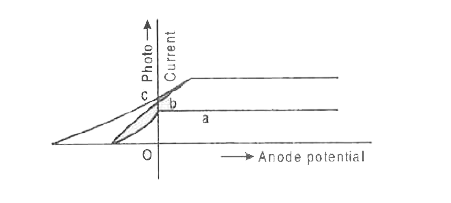Fig. shows variation of photocurrent with anode potential for photosensitive surface for three different radiations. Let Ia,Ib and Ic be the intensities and fa,fb and fc the frequencies for curves a, b to c, then:
 Solution in Kannada
Solution in Kannada
fa=fb,Ia≠Ib
fa=fc,Ia=Ic
fa=fb,Ia=Ib
fb=fc,Ib=Ic
The correct Answer is:A
Saturation current is same for curves .b. and .c. but different for .a.. So Ib=IC&Ia≠Ib. As stopping potential is same for a and b, so fa=fb
Topper's Solved these Questions
- ELECTRONS & PHOTONSBOOK - MODERN PUBLICATIONCHAPTER - ELECTRONS & PHOTONSEXERCISE - MULTIPLE CHOICE QUESTIONS (LEVEL-III)
9 Videos
- ELECTRONS & PHOTONSBOOK - MODERN PUBLICATIONCHAPTER - ELECTRONS & PHOTONSEXERCISE - RECENT COMPETITIVE QUESTIONS
20 Videos
- ELECTRONS & PHOTONSBOOK - MODERN PUBLICATIONCHAPTER - ELECTRONS & PHOTONSEXERCISE - RECENT COMPETITIVE QUESTIONS
20 Videos
- ELECTROMAGNETIC WAVESBOOK - MODERN PUBLICATIONCHAPTER - ELECTROMAGNETIC WAVESEXERCISE - RECENT COMPETITIVE QUESTIONS
4 Videos
- ELECTROSTATICSBOOK - MODERN PUBLICATIONCHAPTER - ELECTROSTATICSEXERCISE - RECENT COMPETITIVE QUESTIONS
39 Videos
Similar Questions
Energy required for the electron excitation in Li++ from the first to the third Bohr orbit is :
View SolutionAccording to Einstein's photoelectric equation the graph of K.E. of the photoelectron emitted from the metal versus the frequency of the incident radiation gives a straight line graph whose slope
View SolutionAccording to Einstein's photoelectric equation the graph of K.E. of the photoelectron emitted from the metal versus the frequency of the incident radiation gives a straight line graph whose slope
View SolutionThe speed of electromagnetic wave in vacuum depends upon the source of radiation
View SolutionTwo small spheres of masses M1andM2 are suspended by weightless insulating threads of lengths L1andL2 The spheres carry charges Q1andq2 respectively . The spheres are suspended such that they are in level with one another and the threads are inclined to the vertical at angles of θ1andθ2 as shown . Which one o fthe following conditions , if θ1=θ2 ?

View SolutionThe curves (a),(b),(c) and (d) show the variation between the applied potential difference (V) and the photoelectric current (i) , at two different intensities of light (I1>I2). In which figure is the correct variation shown ?
View SolutionThe Fig shows a plot of three curves a, b, c showing the variation of photocurrent versis collector plate potential for the different intensities I_1, I_2 and I_3 having frequencies v_1, v_2 and v_3 respectively, incident on a photosensitive surface. Point out the two curves for which the incident radiation have same frequency but different intensities.
View SolutionThe fig. shows the variation of photon current with anode potential for a photo-sensitive surface for three different radiation. Let Ia,IbandIc be the intensities and fa,fbandfc be the frequency for the curves a,b and c respectively.

View Solutionचित्र में तीन विभिन्न आपतित विकिरणों के लिए, एक फोटो-सुग्राही पृष्ठ से प्राप्त प्रकाशवैधुत धारा तथा एनोड विभव के बीच ग्राफ दर्शाये गये हैं । माना कि वक्रों a, b, c के संगत , आपतित विकिरणों कि तीव्रताएँ क्रमशः Ia,Ib,Ic हैं तथा आवृत्तियाँ क्रमशःfa,fb,fc हैं । निम्नलिखित में कौन-सा कथन सत्य है ?

View Solutionचित्र में संग्राहक विभव एवं प्रकाश वैधुत धारा के मध्य तीन वक्र (a), (b) व (c) प्रदर्शित हैं | तीनों वक्रों के संगत प्रकाश की तीव्रताएँ क्रमशः I1,I2 व I3 हैं आवृत्तियाँ , क्रमशः v1,v2

व हैं | दो ऐसे वक्र चिन्हित कीजिए जिनकी आवृत्ति समान हो परन्तु तीव्रता भिन्न हो |
View SolutionThe figures shows th variation of photocurrent i with anode potential V for three differential radiations. Let I_(a)I_(b)" and " I_(c) be the intensities and f_(a),f_(b)" and " f_(c) be the frequencies for the curves a, b and c respectively . Then
View SolutionIn the following figure shows the variation of photocurrent with potential of the collector plate for a photosensitive surface for three different radiations. Let Ia,IbandIc be the intensities and fa,fbandfc be the frequencies for the curves a, b, and c, respectively.

View SolutionThe figure shows a plot of three curves a, b, c, showing variation of photocurrent vs collector plate potential for three different intensities I_(1), I_(2) and I_(3) having frequencies v_(1), v_(2) and v_(3) respectively incident on a photosensitive surface. Point out the two curves for which the incident radioations have same frequency but different intensities.
View SolutionThe fig. shows the variation of photon current with anode potential for a photo-sensitive surface for three different radiation. Let Ia,IbandIc be the intensities and fa,fbandfc be the frequency for the curves a,b and c respectively.

View SolutionThree particles A, B and C of mass m, m and 2m lie in a straight line as shown. The only force acting on these particles is due to the gravitational attraction towards each other. Let the magnitude of net force on them be F_(A), F_(B) and F_(C ) respectively. Then, F_(A):F_(B):F_(C ) is equal to :
View Solution
